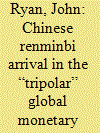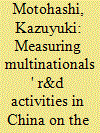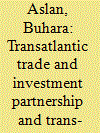|
|
|
Sort Order |
|
|
|
Items / Page
|
|
|
|
|
|
|
| Srl | Item |
| 1 |
ID:
141700


|
|
|
|
|
| Summary/Abstract |
Since the financial crisis hit in 2007, the US dollar privilege has not only become “exorbitant” but “extortianate.” Countries such as China are no longer willing to allow the USA to exercise this extortionate behavior. The potential geopolitical implications of a US dollar decline are immense. The USA would lose its privileged seigniorage position and with that the ability to achieve permanently higher returns on foreign assets than the returns paid to foreigners who invest in the USA. The global economy is already close to operating with three regional exchange rate anchors: the US dollar; the euro; and, increasingly, the renminbi. Hence, the transition to a tripolar system could occur sooner than many assert. Nevertheless, given the importance of financial deepening and integration in the internationalization of currencies, any shift will still be gradual.
|
|
|
|
|
|
|
|
|
|
|
|
|
|
|
|
| 2 |
ID:
141702


|
|
|
|
|
| Summary/Abstract |
This paper examines inflation dynamics in Greater China. Using an asymmetric error correction model, we investigate how inflation in Hong Kong and Macao are related to inflation in Chinese Mainland. Our results based on data from July 1997 to December 2012 reveal that a long-term equilibrium relation exists between inflation in Chinese Mainland and inflation in both Hong Kong and Macao, the two Special Administrative Regions of China. The degree of inflation pass-through is higher for Macao than for Hong Kong. Moreover, we find no evidence of asymmetries in either Hong Kong and Macao's adjustment speeds towards long-run equilibrium or in the short-run pass-through of accelerating or decelerating inflation in the Mainland. Collectively, our results show a close relationship among price dynamics of the three economies and call for a reconsideration of the exchange rate anchor in the Greater China Region.
|
|
|
|
|
|
|
|
|
|
|
|
|
|
|
|
| 3 |
ID:
141698


|
|
|
|
|
| Summary/Abstract |
Using an internationally linked patent database, this paper compares the types of R&D activities undertaken by multinationals in China by home country and industry. In China, multinationals recently began investing in R&D, mainly in the areas of product and manufacturing process development. However, US firms, which are the most actively invested in R&D, are involved in some technology-driven R&D activities; European firms are inclined toward market-driven R&D, while Japanese firms, which lag behind the other two, focus on production-driven R&D. This pattern may be related to the relative competitiveness of each country: Japanese firms are strong in electronics and automobiles, where production process improvement is important, while US firms flourish in science-based industries, such as pharmaceuticals and software, where interacting with the local science base is a critical factor.
|
|
|
|
|
|
|
|
|
|
|
|
|
|
|
|
| 4 |
ID:
141701


|
|
|
|
|
| Summary/Abstract |
This paper provides new evidence on export price elasticities by analyzing the cases of China, France, Germany, Italy, Japan, UK and the USA over the period 1990–2012. Estimates have been made using panel data techniques for non-stationary data. After demonstrating that long-run relationships are stable to any structural break, it is found that exports are significantly determined by foreign demand, with long-run income elasticity significantly higher than unity for China, Japan, Germany, the UK and the USA. Conversely, exports are price inelastic for most of the countries in the sample, in both the long run and the short run. The exception is France, whose export price elasticity is lower (higher) than unity in the short run (long run).
|
|
|
|
|
|
|
|
|
|
|
|
|
|
|
|
| 5 |
ID:
141703


|
|
|
|
|
| Summary/Abstract |
During the past decade, China's outward direct investment (ODI) and exports have experienced rapid growth, drawing increasing attention to the relationship between them. Using the gravity model based on panel data on China's ODI and trade to 174 countries and regions during 2003–2012, the present paper investigates the impacts of China's ODI on exports. We find that China's ODI to a host country significantly promotes China's trade with that economy: a 10-percent increase in ODI stock can lead to a 2.14-percent increase in exports, a 2.07-percent increase in imports and a 2.87-percent increase in net exports. The scale of the host country's economy, its infrastructure and its distance to China also have significant impacts on China's exports. Therefore, growth in ODI will facilitate China's trade and integration into the global economy, and enhance industrial upgrading in China by transferring the low-end industries abroad.
|
|
|
|
|
|
|
|
|
|
|
|
|
|
|
|
| 6 |
ID:
141699


|
|
|
|
|
| Summary/Abstract |
As a result of deadlocked multilateral trade negotiations, many countries have embarked on the establishment of bilateral and regional trade agreements. Using the Global Trade Analysis Project database and a computable general equilibrium model, our paper focuses on the impacts of the Transatlantic Trade and Investment Partnership (TTIP) and the Trans-Pacific Partnership (TPP) on the Chinese economy under three scenarios. The results suggest that when only the TTIP is realized, Chinese economic variables are negatively affected. When both the TTIP and the TPP are realized and China is excluded, the combined damage to the Chinese economy is higher than the damage with the TTIP alone. However, the inclusion of China in the TPP has a positively effect on economic variables in China. This indicates that the impacts of China's participation in the TPP compensate for the negative impacts of the TTIP. Therefore, China should consider being part of the TPP to offset the negative impacts of the TTIP.
|
|
|
|
|
|
|
|
|
|
|
|
|
|
|
|
|
|
|
|
|